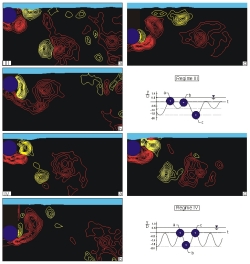You are here
Home ›Vortex Patterns due to Self-Excited Oscillations of a Horizontal Cylinder at and Near a Free-Surface: Part B
Vortex patterns due to self-excited oscillations of a horizontal cylinder at and near a free-surface. Images corresponding to regimes III and IV (defined in the schematic of the previous layout) show vortex patterns associated with limit cycle vibrations of the cylinder. In regime III, relatively large-amplitude oscillations occur in a modulated pattern defined by the plot of y/D vs. t. During the oscillation cycle, substantial piercing of the free-surface occurs, such that the center of the cylinder is approximately located at the elevation of the undisturbed free-surface. During the first part of the oscillation cycle, the concentration of negative (yellow) vorticity from the upper surface of the cylinder forms a counterrotating vortex pair with the positive (red) concentration from the lower surface. Later in the oscillation cycle, the negative concentration glides in the horizontal direction beneath the free-surface, and tends to form a vortex street with the positive (red) concentration.
At a larger value of reduced velocity Vr, the cylinder vibration occurs in regime IV, which corresponds to periodic, limit-cycle oscillations. In this case, the formation of counterrotating vortex pairs is consistently evident at successive peak amplitudes of the cylinder motion.
A horizontal, elastically-mounted cylinder of low mass-damping parameter is oriented horizontally at various depths of submergence beneath a free-surface. Variations of the velocity of the steady inflow yield a number of states of self-excited oscillation of the cylinder. These states include sinusoidal and modulated oscillations. Hysteresis effects, whereby different states are attained for increasing, versus decreasing, flow velocity are particularly pronounced. These states, characterized in terms of the dimensionless amplitude of oscillation as a function of reduced velocity, are physically interpreted using a technique of high-image-density particle image velocimetry, leading to identification of well-defined patterns of single and co-rotating vortex systems.

